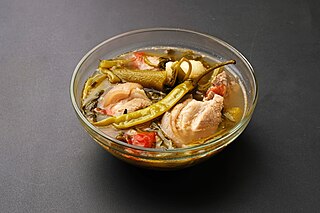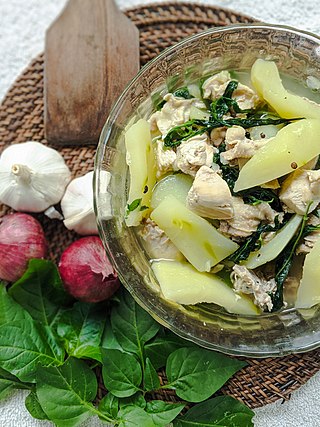
Sinigang is a Filipino soup or stew characterized by its sour and savory taste. It is most often associated with tamarind, although it can use other sour fruits and leaves as the souring agent. It is one of the more popular dishes in Filipino cuisine. The soup is usually accompanied by rice. In 2021, sinigang was rated as the world's best vegetable soup by TasteAtlas. In December 2023, the website project's TasteAtlas Awards 2023/24 included sinigang among its "100 best dishes in the world".

Tinola is a Filipino soup usually served as a main course with white rice. Traditionally, this dish is cooked with chicken or fish, wedges of papaya and/or chayote, and leaves of the siling labuyo chili pepper in broth flavored with ginger, onions and fish sauce.

Pancit, also spelled pansít, is a general term referring to various traditional noodle dishes in Filipino cuisine. There are numerous types of pancit, often named based on the noodles used, method of cooking, place of origin, equal and constant diameter or the ingredients. Most pancit dishes are characteristically served with calamansi, as its freshly squeezed juice may be used for additional seasoning.

Ginataan, alternatively spelled guinataan, is a Filipino term which refers to food cooked with gatâ. Literally translated, ginataan means "done with coconut milk". Due to the general nature of the term, it can refer to a number of different dishes, each called ginataan, but distinct from one another.

Bicol Express, known natively in Bikol as sinilihan, is a popular Filipino dish which was popularized in the district of Malate, Manila but made in traditional Bicolano style. It is a stew made from long chili peppers or small chili peppers, coconut milk/coconut cream, shrimp paste or stockfish, onion, pork, ginger and garlic. The dish was termed by Laguna resident, Cely Kalaw, during a cooking competition in the 1970s in Malate, Manila. The name of the dish was inspired by the Bicol Express railway train that operated from Tutuban, Manila to Legazpi, Albay. The widely-known name for this dish in the Bicol Region of the Philippines was identified as gulay na may lada, which is currently one of the vegetarian variants of the Bicol Express dish. As time progressed, variants of the Bicol Express dish expanded with seafood, beef, pescatarian, vegetarian, vegan, and other versions. The preparations for these dishes vary according to the meat present within the dish. In terms of nutritional value, the original version of the Bicol Express dish is beneficial in protein but unhealthy in regards to its high levels of saturated fats and cholesterol. The dish has moved into food processing and commercial production so that it can be sold conveniently and stored for a longer period of time.

Laing, is a Filipino dish of shredded or whole taro leaves with meat or seafood cooked in thick coconut milk spiced with labuyo chili, lemongrass, garlic, shallots, ginger, and shrimp paste. It originates from the Bicol Region, where it is known simply as pinangat. Laing is also a type of ginataan, and thus may also be referred to as ginataang laing. Laing is commonly eaten as a vegetable side to complement meat or fish side dishes known as ulam in Filipino, which is normally paired with boiled white rice.

Paksiw is a Filipino style of cooking, whose name means "to cook and simmer in vinegar". Common dishes bearing the term, however, can vary substantially depending on what is being cooked.

Nilaga is a traditional meat stew or soup from the Philippines, made with boiled beef or pork mixed with various vegetables. It is typically eaten with white rice and is served with soy sauce, patis, labuyo chilis, and calamansi on the side.

Ginataang kalabasa, also known as kalabasa sa gata, is a Filipino vegetable stew made from calabaza in coconut milk and spices. It commonly includes shrimp and yardlong beans and either bagoong or patis. It can also be cooked with fish, crab, or meat and a variety of other ingredients. It is a creamy umami-laden dish that is naturally slightly sweet due to the calabaza. It is a type of ginataan.

Ginataang langka, is a Filipino vegetable stew made from unripe jackfruit in coconut milk and spices. The dish includes a wide variety of secondary ingredients like seafood, meat, and other vegetables. The dish also commonly adds bagoong alamang and may be spiced with chilis or soured with vinegar. Notable variants of the dish are ginataang kamansi and ginataang rimas which use breadnut and breadfruit, respectively. Ginataang langka is a type of ginataan.

Ginataang hipon is a Filipino seafood soup made from shrimp (hipon) in coconut milk (gata) and spices. It differs from other types of ginataan, in that it does not use vegetables. It is a type of ginataan. Variants of the dish include ginataang curacha and ginataang sugpo, which use spanner crabs and prawn, respectively, in place of shrimp.

Sinantolan, also known as ginataang santol or gulay na santol, is a Filipino dish made with grated santol fruit rinds, siling haba, shrimp paste, onion, garlic, and coconut cream. Meat or seafood are also commonly added, and a spicy version adds labuyo chilis. It originates from Southern Luzon, particularly from the Quezon, Laguna, and Bicol regions. It is a type of ginataan.

Ginataang ampalaya, is a Filipino vegetable stew made from bitter melon and tinapa in coconut milk, bagoong alamang, and spices. The dish can also be made with pork or shrimp and other vegetables. The dish is characteristically savory and slightly bitter due to the ingredients used. It is a type of ginataan.

Ginataang isda is a Filipino fish stew made from fish and leafy vegetables in coconut milk with garlic, ginger, onion, patis or bagoong alamang, and salt and pepper. It is a type of ginataan. A common version of the dish, known as ginataang paksiw na isda or paksiw na isda sa gata, is additionally soured with vinegar. Ginataang isda is a type of ginataan.

Ginataang manok is a Filipino chicken stew made from chicken in coconut milk with green papaya and other vegetables, garlic, ginger, onion, patis or bagoong alamang, and salt and pepper. It is a type of ginataan. A common variant of the dish adds curry powder or non-native Indian spices and is known as Filipino chicken curry.
Binakol, also spelled binakoe, is a Filipino chicken soup made from chicken cooked in coconut water with grated coconut, green papaya, leafy vegetables, garlic, onion, ginger, lemongrass, and patis. It can also be spiced with chilis. Binakol can also be cooked with other kinds of meat or seafood. It was traditionally cooked inside bamboo tubes or directly on halved coconut shells. The dish originates from the Western Visayas, particularly the province of Aklan.

Ginataang kuhol is a Filipino snail stew made from apple snails in coconut milk with leafy vegetables, onion, garlic, ginger, siling haba chilis, bagoong alamang, and salt and pepper. Labuyo chilis are also commonly added for a spicier version. The leafy vegetables can include water spinach, moringa leaves, and chili pepper leaves, among others.

Ginataang labong or ginataang tambo is a Filipino vegetable stew made from bamboo shoots in coconut milk and spices with seafood or meat. It is the most common way of preparing bamboo shoots in Philippine cuisine. Ginataang ubod is a variant of the dish made with heart of palm but is otherwise prepared identically. It is a type of ginataan.

Sinanglay is a Filipino dish made from stuffed fish wrapped in leafy vegetables and lemongrass or pandan leaves cooked in a spicy coconut milk sauce. It is a type of ginataan and originates from the Bicol Region.


















